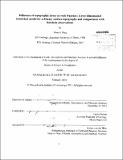| dc.contributor.advisor | Taylor Perron. | en_US |
| dc.contributor.author | Slim, Mirna I | en_US |
| dc.contributor.other | Massachusetts Institute of Technology. Department of Earth, Atmospheric, and Planetary Sciences. | en_US |
| dc.date.accessioned | 2013-06-17T19:54:17Z | |
| dc.date.available | 2013-06-17T19:54:17Z | |
| dc.date.copyright | 2013 | en_US |
| dc.date.issued | 2013 | en_US |
| dc.identifier.uri | http://hdl.handle.net/1721.1/79300 | |
| dc.description | Thesis (S.M. in Geophysics)--Massachusetts Institute of Technology, Dept. of Earth, Atmospheric, and Planetary Sciences, 2013. | en_US |
| dc.description | Cataloged from PDF version of thesis. | en_US |
| dc.description | Includes bibliographical references (p. 73-75). | en_US |
| dc.description.abstract | Theoretical calculations indicate that topographic stresses in some landscapes may be large enough to fracture rocks, which in turn could influence slope stability, erosion rates, and bedrock hydrologic properties. These predictions typically have involved idealized topographic profiles, with few direct comparisons of predicted topographic stresses and observed fractures at specific field sites. I use a numerical model to calculate the stresses induced by measured topographic profiles and specified far-field tectonic stress. I compare the calculated stress field and potential shear fracture orientations with fracture abundance and fracture orientations observed in shallow boreholes. The model uses a boundary element method to calculate the stress distribution beneath an arbitrary topographic profile. When applied to topographic profiles extracted from a laser altimetry map of the Susquehanna/Shale Hills Critical Zone Observatory in central Pennsylvania, the model predicts considerable differences in depth profiles of stresses beneath ridgelines and valley floors. Using a representative value for the friction angle of shale, we calculate the minimum cohesion required to prevent shear failure, Cmin, as a proxy for the potential for fracturing or reactivation of existing fractures. We compare depth profiles of Cmin with structural analyses of image logs from four boreholes located on the valley floor, and find that fracture abundance declines sharply with depth in the uppermost 10 m of the boreholes, consistent with the modeled profile of Cm.. In contrast, Cmin increases with depth below ridgetops, suggesting that future analyses of ridgetop wells should observe a different trend in fracture abundance if topographic effects are indeed important. The numerical model used assumes the subsurface to be homogeneous and isotropic. The model-predicted fracture orientations do not reflect the scatter in fracture orientations seen in the wells. Thus, the present results support the hypothesis that topography can influence subsurface rock fracture patterns, suggest the imitation and reactivation of fractures of different generations, and provide a basis for further observational tests. | en_US |
| dc.description.statementofresponsibility | by Mirna I. Slim. | en_US |
| dc.format.extent | 75 p. | en_US |
| dc.language.iso | eng | en_US |
| dc.publisher | Massachusetts Institute of Technology | en_US |
| dc.rights | M.I.T. theses are protected by
copyright. They may be viewed from this source for any purpose, but
reproduction or distribution in any format is prohibited without written
permission. See provided URL for inquiries about permission. | en_US |
| dc.rights.uri | http://dspace.mit.edu/handle/1721.1/7582 | en_US |
| dc.subject | Earth, Atmospheric, and Planetary Sciences. | en_US |
| dc.title | Influence of topographic stress on rock fracture : a two-dimensional numerical model for arbitrary surface topography and comparisons with borehole observations | en_US |
| dc.type | Thesis | en_US |
| dc.description.degree | S.M.in Geophysics | en_US |
| dc.contributor.department | Massachusetts Institute of Technology. Department of Earth, Atmospheric, and Planetary Sciences | |
| dc.identifier.oclc | 847523507 | en_US |
